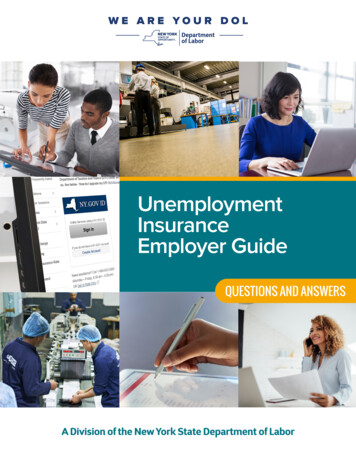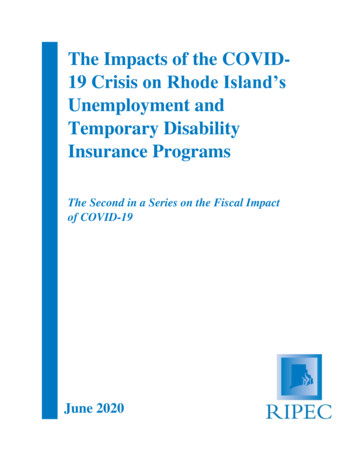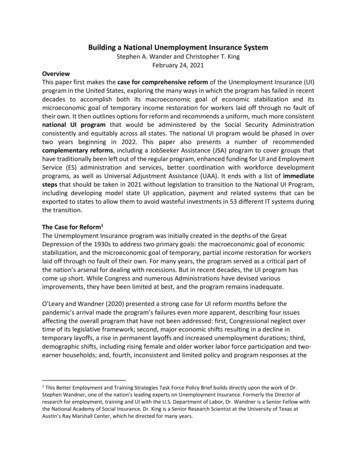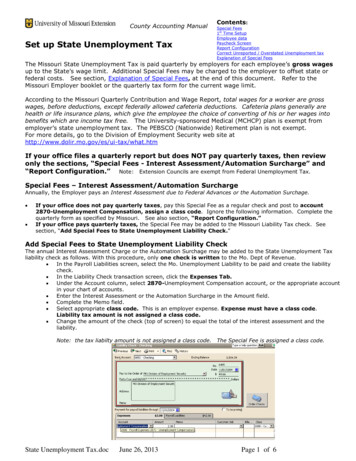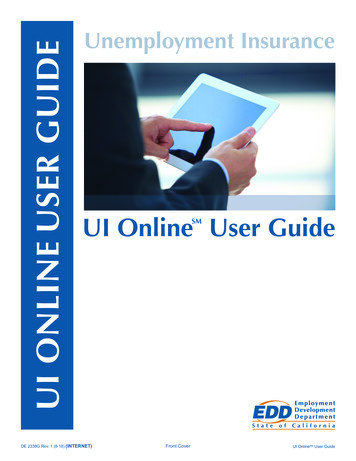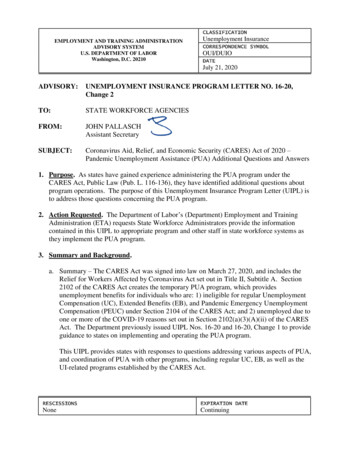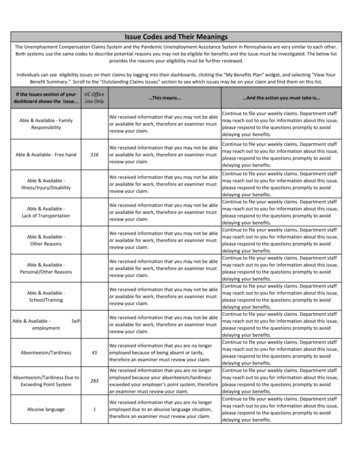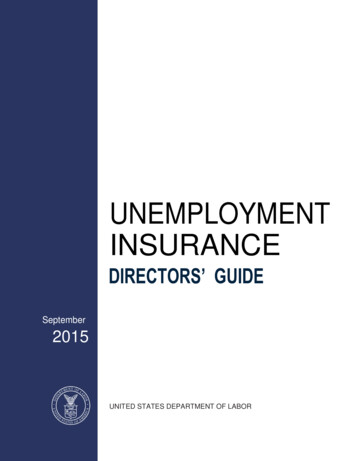
Transcription
UNEMPLOYMENTINSURANCEDIRECTORS’ GUIDESeptember2015UNITED STATES DEPARTMENT OF LABOR
Unemployment Insurance Directors’ Guide:Essential Elements for the UnemploymentInsurance (UI) DirectorSeptember 2015U.S. Department of Labor – Employment and Training Administration – Office of Unemployment Insurance
Table of ContentsExecutive Summary . 1Introduction . 3Conformity Requirements for State UC Laws . 5Federal Law Provisions Relating to Administration . 5Financing Unemployment Insurance Benefits . 6Unemployment Insurance Tax . 7Approval for Tax Credit . 7Unemployment Trust Fund . 9Provisions Relating to Trust Fund Advances (Also Known As Loans) . 10Interest on Loans . 10State Administrative Funding . 11Approval for Grants for Costs of Administration . 11Administrative Funding Process . 13Resource Justification Model . 13Base and Above-Base Funding . 14Special Funding Opportunities . 14Supplemental Budget Requests . 14Reed Act Funds . 15State Trust Funds . 15State Unemployment Insurance Tax . 16Liable Employers . 17Experience Rating and the Federal Requirements . 17State Requirements for Experience Rating . 18Reimbursing Employers . 18Worker Misclassification . 18SUTA Dumping . 19Unemployment Insurance Benefits . 19Benefits Rights . 19Qualifying Wages and Employment . 20Unemployment Compensation Computation . 20Benefit Eligibility and Disqualification . 20Unemployment Insurance Directors’ Guide — September 2015i
Filing a Claim . 21Continued Eligibility . 21Appeals . 22Other Unemployment Insurance Benefits Programs . 23Federal-State Extended Benefits . 23Temporary/Episodic Federal Unemployment Compensation Extension Programs . 24Unemployment Compensation for Federal Civilian Employees. 24Unemployment Compensation for Ex-Servicemembers . 24Disaster Unemployment Assistance . 25Trade Adjustment Assistance / Trade Readjustment Allowances. 25Self-Employment Assistance . 26Short-Time Compensation . 26Worker Profiling and Reemployment Services . 27Reemployment Services and Eligibility Assessments . 27UI and the Workforce Innovation and Opportunity Act . 28Administrative Infrastructure . 29Call Center and Web site Operations . 29Information Technology Infrastructure . 29State Information Data Exchange System (SIDES) . 30Interstate Connection Network. 30Staffing. 30Merit Staffing . 31Program Performance and Accountability . 32UI Performs Performance Management System . 32State Quality Service Plan . 35Benefits Timeliness and Quality . 36UI Benefit Operational Functional Review—New State Self-Assessment Tool . 36Tax Performance System . 37Lower Authority Appeals Quality Reviews . 39Program Reporting & Data . 39Financial Reporting . 39Federal ETA Performance Reports . 40Unemployment Insurance Directors’ Guide — September 2015ii
UI Program Integrity . 41Everyone Owns Integrity . 41Federal Improper Payment Laws . 42Benefits Accuracy Measures . 43Use of BAM Data for Program Improvement . 43Overpayment Detection Core Measure Ranking Report. 44Unemployment Insurance Recovery Core Measures . 45Benefit Payment Control . 45Treasury Offset Program . 45Penalty and Interest Funds . 46Confidentiality . 46The U.S. Department of Labor . 49Department of Labor Unemployment Insurance Structure . 50Office of Unemployment Insurance . 50ETA’s Regional Offices . 52Office of Inspector General . 53Key State Agency Personnel With Whom You Will Interact Regularly . 54Unemployment Insurance Advisory Council . 54UI and the State’s Workforce System . 55U.S. Department of Labor Resources . 55Other Resources . 56USDOL Advisories and Guidance . 59Directory of U.S. Department of Labor National and Regional Offices . 60Employment and Training Administration (ETA) Regional Offices . 60Unemployment Insurance Acronyms . 62Unemployment Insurance Directors’ Guide — September 2015iii
Executive SummaryThis Unemployment Insurance (UI) Directors’ Guide is a resource of information about theUnemployment Insurance (UI) program that has been developed for UI Directors by the U.S.Department of Labor’s (USDOL’s) Employment and Training Administration’s Office ofUnemployment Insurance.The guide outlines the principles establishing the UI program, including information about theSocial Security Act and the Federal Unemployment Tax Act—the foundations upon which stateshave built their UI systems. It provides information on the requirements states must meet to bein conformity and compliance with Federal law.Other topics covered in this guide include the administrative funding process; the requirements astate must meet to be eligible to receive grants for the costs of administration; and informationabout the Resource Justification Model (RJM), base and above-base funding, SupplementalBudget Requests (SBR), and Reed Act funds. Other fiscal-related topics include the methods offinancing UI benefits; UI tax provisions; trust fund composition and management; trust fundadvances (loans) during high-unemployment periods; administrative funding for programoperations; and employer tax account types and related tax calculation methodologies.UI benefit programs are explained in detail, including information regarding how an individual’smonetary entitlement and eligibility are determined; disqualifications and ineligibilities; anddescriptions of the claim types available, including intrastate and interstate claims, combinedwage claims, Unemployment Compensation for Federal Employees, UnemploymentCompensation for Ex-servicemembers, Disaster Unemployment Assistance and Federal-StateExtended Benefits, and Short-Time Compensation.Federal initiatives that affect UI claimants such as the Worker Profiling and ReemploymentServices (WPRS), Reemployment Services and Eligibility Assessments (RESEA), and theWorkforce Innovation and Opportunity Act (WIOA) are also detailed.The guide includes information concerning the many program performance and accountabilityprocesses for the UI system, including the Benefits Timeliness, and Quality (BTQ) process;Appeals reviews; and the Tax Performance System (TPS). In addition to these reviews,beginning in Federal Fiscal Year (FFY) 2016 a new self-assessment tool will be piloted inseveral states that will allow each state to review a wide range of its UI operational elementswithin the UI benefits’ functional areas.The guide also describes integrity and quality initiatives, and the programs that are in place tomonitor key performance measures and to inform corrective action when needed, including theState Quality Service Plan (SQSP) process. A point of emphasis regarding program integrityinvolves the level of improper payments in the state and initiatives that have been implementedUnemployment Insurance Directors’ Guide — September 20151
to reduce the improper payment rate and facilitate recovery of those improper payments.Additionally, helpful information is provided regarding staffing regulations, including the use ofmerit staff.In many instances, hyperlinks are provided to resource documentation, such as applicableFederal law and other helpful information, including USDOL guidance advisories, the FederalRegister, and Code of Federal Regulations. USDOL web pages provide a variety of informationsuch as data on program performance, budget, comparison of state UI laws, and programhandbooks. Information is also provided concerning National Association of State WorkforceAgencies (NASWA), the Information Technology Support Center (ITSC), and the UI IntegrityCenter of Excellence, which are organizations that work closely with USDOL providing servicesand support to states.Unemployment Insurance Directors’ Guide — September 20152
IntroductionThe Federal-State unemployment compensation (UC) program, (also referred to as theunemployment insurance [UI] program), created by the Social Security Act (SSA) of 1935,offers the first economic line of defense against the effects of unemployment. Throughpayments made directly to eligible, unemployed workers, it ensures that at least a significantproportion of the necessities of life—most notably food, shelter, and clothing—can be met on aweek-to-week basis while a search for work takes place. As temporary, partial wagereplacement to the unemployed, UC is of vital importance in maintaining purchasing power andin stabilizing the economy in times of economic downturn. This is evidenced by the numerousstudies which have found that during times of high unemployment each dollar of UC benefitspaid will result in between 1.55 to 2.00 of economic activity.*In addition to providing workers a much-needed safety net, the UC program provides employersthe benefit of maintaining a trained workforce in the local labor market, available to return towork when needed. The UC program operates counter-cyclically, paying out higher levels ofbenefits during recessionary times and recouping those higher costs during recovery periods.Most workers are covered by UC under state or Federal UC laws. States are responsible foradministering their individual state UC programs, and they act as agents of the Federalgovernment in administering certain Federal UC programs (discussed below) under agreementswith the Secretary of Labor.Unemployment compensation is a social insurance program, but unlike many other safety netprograms, eligibility for UC is not means-tested—all qualifying workers regardless of means areentitled to the benefits of this program. Entitlement is established only if the claimant has asufficient employment history, in accordance with the state’s UC law. It is designed to providebenefits to eligible individuals who are unemployed (or partially unemployed) due to nondisqualifying reasons under the state UC law. To qualify for benefits, jobless workers mustdemonstrate workforce attachment, must be able to work and available for work, and generallymust meet other eligibility requirements while they seek work. UC benefits are financed almostwholly through an employer tax that is based upon their experience in the unemploymentcompensation system; that is, the length of time they have operated in the state, the amount ofunemployment tax paid, the amount of unemployment benefits paid to their workers, and theemployer’s industry.The regular state UC program is a Federal-State partnership based upon Federal law, butadministered by state employees under state law. Because of this structure, the program isFor example, see 2010 IMPAQ study “The Role of Unemployment Insurance as an Automatic stabilizerDuring a Recession” fs.htm*Unemployment Insurance Directors’ Guide — September 20153
unique among the country's social insurance programs. The UC program is also unique in that itis almost totally funded by employer taxes, either Federal or state. However, three states collecttaxes from employees.The Social Security Act (SSA) (http://www.ssa.gov/OP Home/ssact/title03/0303.htm) and theFederal Unemployment Tax Act (FUTA) rovide broad coverage provisions, some benefit provisions, the Federal tax base and rate, andadministrative requirements.The following responsibilities are the major functions of the Federal government: ensure conformity and substantial compliance of state law, regulations, rules, andoperations with Federal law, determine administrative fund requirements and provide money to states for proper andefficient administration, interpret Federal law, set broad overall policy for administration of the program, developperformance accountability metrics and reporting processes, monitor state performance,and provide technical assistance to states, hold and invest all money in the unemployment trust fund (UTF) until drawn down bystates for the payment of compensation, and provide advances to states whose accounts in the UTF have insufficient funds to pay UCwhen due.Conformity: The Social Security Act and Federal Unemployment Tax Act provide the provisions thatmust be met and states must design their UC program within the framework of theseFederal requirements. State law, regulations, and judicial decisions must conform to theserequirements. The state’s conformity to Federal laws and regulations is subject to annual certification bythe U.S. Department of Labor’s Secretary.Compliance: A state must be in substantial compliance with its own law that conforms to therequirements of Federal law for the operation of the state’s UC programs.State law must also be certified before tax credits and administrative funds can be continued. Astate’s failure to meet conformity and compliance requirements will lead to decertification of thestate law and loss of all employer tax credits (see Unemployment Insurance Tax) and loss ofgrants for costs of administration.Unemployment Insurance Directors’ Guide — September 20154
Conformity Requirements for State UC LawsFederal Law Provisions Relating to AdministrationSection 303(a) SSA (http://www.ssa.gov/OP Home/ssact/title03/0303.htm) provides that, as acondition of a state receiving its UC administrative grant, the Secretary of Labor must certifyannually that the law of the state includes certain requirements: Section 303(a)(1) requires such methods of administration (including a state merit system)which are found by the Secretary of Labor to be reasonably calculated to ensure fullpayment of unemployment compensation “when due.” Section 303(a)(2) requires payment of benefits through public employment offices or suchother agencies as the Secretary of Labor may approve. Section 303(a)(3) requires the opportunity for a fair hearing, before an impartial tribunal,for all individuals whose claims for unemployment compensation are denied. Section 303(a)(4) requires the immediate deposit of all money received for theunemployment fund with the Secretary of the Treasury to the credit of the state’s accountin the fund. Section 303(a)(5) requires the expenditure of all moneys withdrawn for the state’sunemployment fund be used only for the payment of unemployment compensation,exclusive of the expenses of administration. Section 303(a)(6) requires states to make reports, containing such information and in suchform, as the Secretary of Labor may from time to time require. Section 303(a)(7) requires states to provide certain claimant information to Federalagencies administering public work programs or assistance through public employment. Section 303(a)(8) requires states to limit expenditures to purposes and amounts foundnecessary by the Secretary of Labor for proper and efficient administration of the stateunemployment compensation law. Section 303(a)(9) requires states to return amounts which have been lost or expended forpurposes which the Secretary of Labor has found not necessary for proper administrationof the state law. Section 303(a)(10) contains the profiling “participation requirement.” As a condition ofUC eligibility, claimants must participate in reemployment services if they have beenreferred under a "profiling" system established under §303(j), SSA.Unemployment Insurance Directors’ Guide — September 20155
Each state designs its own UC program within the framework of the Federal requirements. Thestate statute sets forth the benefit structure (e.g., eligibility/disqualification provisions, benefitamount) and the state tax structure (e.g., state taxable wage base and tax rates). Theseresponsibilities are the primary functions of the state: determine operation methods and directly administer the program, take claims from individuals, determine eligibility, and insure timely payment of benefitsto eligible workers, and determine employer liability, and assess and collect contributions.Most states currently pay a maximum of 20 to 26 weeks, although Massachusetts pays up to 30weeks. A few states predicate the maximum number of week’s payable on the state’sunemployment rate. In periods of very high and rising unemployment in individual states,benefits are payable for up to 13 additional weeks (20 in some cases), up to a maximum of 39weeks (or 46). These "extended benefits" are funded on a shared basis—half from state fundsand half from Federal sources.In periods of national recession, when all states are impacted by high and sustainedunemployment, Congress may enact Federally-funded programs of supplemental benefits. Therewere two such programs during the 1970s, one during the early 1980s, one during the 1990s, andone during the early 2000s. The most recent extension program was the EmergencyUnemployment Compensation program of 2008 (EUC08), which was effective from July 2008,through January 1, 2014.Financing Unemployment Insurance BenefitsPursuant to the provisions of the FUTA, a Federal tax is levied on covered employers at a currentrate of 6.0 percent on wages up to 7,000 a year paid to an employee. The rate dropped from 6.2percent as of July 2011. The law, however, provides a credit against Federal tax liability of up to5.4 percent to employers who pay state taxes timely under an approved state UC program. Thiscredit is allowed regardless of the amount of the tax paid to the state by the employer.Accordingly, in states meeting the specified requirements, employers pay an effective Federaltax rate of 0.6 percent, or a maximum 42 per covered employee, per year.This Federal tax is used to fund a number of UC related expenditures, including the followingexpenditures: all Federal and state administrative costs associated with UC programs (this is the sourceof your state’s administrative grants), the Federal share of benefits paid under the Federal-State Extended UnemploymentCompensation Act of 1970,Unemployment Insurance Directors’ Guide — September 20156
the loan fund for advances to states under Title XIII of the SSA, from which an individualstate may borrow when it lacks funds to pay UC due for any month, and benefits under some of the Federal supplemental and emergency programs.In addition, the FUTA tax is used to fund labor exchange services, employment and trainingservices for veterans and disabled veterans, and some labor market information programactivities.Under FUTA, states must have a taxable wage base of at least 7000, but most states have ahigher taxable wage base.Unemployment Insurance TaxAlmost all wage and salary workers are now covered by the Federal-State UC program. Railroadworkers are covered by a separate Federal program. Ex-servicemembers with recent service inthe Armed Forces and civilian Federal employees are covered by separate Federal programs,with the states paying benefits from Federal funds as agents of the Federal government. SeeOther Unemployment Insurance Benefits Programs for more information regarding theUnemployment Compensation for Federal Employees and Unemployment Compensation for Exservicemembers for more information regarding these programs.If a state law meets minimum Federal requirements under FUTA and Title III of the SSA, thestate is entitled to the following benefits: employers receive up to a 5.4 percent basic and additional tax credit against the 6.0 percentFederal unemployment tax, and the state is entitled to Federal grants to cover all the necessary costs of administering theprogram.Approval for Tax CreditAdditional conformity requirements are outlined in Sections 3.pdf) and 3304 f) of the Internal Revenue Codeof 1986 (created by the law known as FUTA). These provisions define some of the minimumFederal requirements for operating a UC program and provide that the Secretary of Labor shallapprove a state law for basic and additional tax credit (as noted above) if the state law includesthe following provisions: Compensation is not denied to anyone who refuses to accept work because the job isvacant as the direct result of a labor dispute; or because the wages, hours, or conditions ofwork are substandard; or if, as a condition of employment, the individual would have toUnemployment Insurance Directors’ Guide — September 20157
join a company union or resign from or refrain from joining any bona fide labororganization. Compensation is paid to employees of state and local governments and Indian tribes. Compensation is paid to employees of FUTA tax exempt nonprofit organizations,including schools and colleges, who employ 4 or more workers in each of 20 weeks in thecalendar year. Payment of compensation to certain employees of educational institutions operated by stateand local governments, nonprofit organizations, and Indian tribes is limited during periodsbetween and within academic terms. State and local governments, nonprofit organizations, and Indian tribes are permitted toelect to pay regular employer contributions or finance benefit costs by the reimbursementmethod. Compensation is not payable in two successive benefit years to an individual who has notworked after the beginning of the first benefit year. Compensation is not denied to anyone solely because the individual is taking part in anapproved training program. Compensation is not denied or reduced because an individual's claim for benefits was filedin another state or Canada and the state participates in arrangements for combining wagesearned in more than one state for eligibility and benefit purposes. Compensation is not denied by reason of cancellation of wage credits or total benefit rightsfor any cause other than discharge for work-connected misconduct, fraud in connectionwith a claim for compensation, or receipt of disqualifying income. Extended compensation is payable under the provisions of the Federal-State ExtendedUnemployment Compensation Act of 1970 (Federal-State extended benefits program). Compensation is not denied solely on the basis of pregnancy or termination of pregnancy. Compensation is not payable to a professional athlete, between seasons, who has areasonable assurance of re
compensation system; that is, the length of time they have operated in the state, the amount of unemployment tax paid, the amount of unemployment benefits paid to their workers, and the employer's industry. The regular state UC program is a Federal-State partnership based upon Federal law, but administered by state employees under state law.
